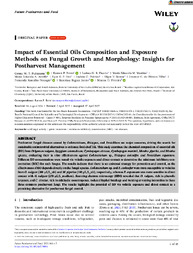Impact of Essential Oils Composition and Exposure Methods on Fungal Growth and Morphology: Insights for Postharvest Management.
Impact of Essential Oils Composition and Exposure Methods on Fungal Growth and Morphology: Insights for Postharvest Management.
Autoria: FUKUYAMA, C. W. T.; BREXÓ, R. P.; DUARTE, L. G. R.; MARTINS, M. E. M.; ASTOLFO, M. E. A.; OSTI, Y. G. P.; PEDRINO, I. C.; SANTOS, H. V.; OLIVEIRA FILHO, J. G. de; PROCOPIO, F. R.; BOGUSZ JUNIOR, S.; FERREIRA, M. D.
Resumo: Postharvest fungal diseases caused by Colletotrichum, Rhizopus, and Penicillium are major concerns, driving the search for sustainable antimicrobial alternatives to enhance food shelf life. This study examines the chemical composition of essential oils (EO) from Origanum vulgare, Syzygium aromaticum, Cymbopogon citratus, Cymbopogon martinii, Mentha piperita, and Mentha spicata, evaluating their in vitro effectiveness against Colletotrichum sp., Rhizopus stolonifer, and Penicillium expansum. Different EO concentrations were tested via volatile exposure and direct contact to determine the minimum inhibitory concentration (MIC) for each fungus. The results indicate that there is no universal strategy for prevention and control, as the effectiveness of EO depends directly on the fungal species. Colletotrichum sp. and R. stolonifer were more susceptible to volatiles from O. vulgare (200 ?L/L_air) and M. piperita (180 ?L/L_air), respectively, whereas P. expansum was more sensitive to direct contact with O. vulgare (250 ?L/L_medium). Scanning electron microscopy (SEM) revealed that O. vulgare, rich in phenolic terpenes, and C. citratus, rich in aldehydic monoterpenes, induced hyphal breakage and twisting at varying intensities in these three common postharvest fungi. The results highlight the potential of EO via volatile exposure and direct contact as a promising alternative for postharvest fungal control.
Ano de publicação: 2025
Tipo de publicação: Artigo de periódico
Unidade: Embrapa Instrumentação
Palavras-chave: Antifungal activity, Green treatments, Minimum inhibitory concentration (MIC), Rot diseases
Observações
1 - Por padrão são exibidas publicações dos últimos 20 anos. Para encontrar publicações mais antigas, configure o filtro ano de publicação, colocando o ano a partir do qual você deseja encontrar publicações. O filtro está na coluna da esquerda na busca acima.
2 - Para ler algumas publicações da Embrapa (apenas as que estão em formato ePub), é necessário ter, no celular ou computador, um desses softwares gratuitos. Sistemas Android: Google Play Livros; IOS: iBooks; Windows e Linux: software Calibre.
Acesse outras publicações
Acesse a Base de Dados da Pesquisa Agropecuária (BDPA) para consultar o acervo completo das bibliotecas da Embrapa.

